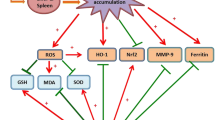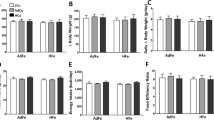Abstract
Curcumin as active metal chelating and antioxidant agent has a potential role in metal reduction and free radicals’ neutralization in tissues. Of note, long-term administration of high fat diet (HFD) is considered as a main factor of blood serum iron deficiency. This study aimed to investigate the biodistribution profiles of iron in the spleen after long-term administration of HFD along with iron supplementation. Furthermore, the ameliorative role of curcumin to reduce iron accumulation level and improve the histological abnormalities produced by iron in spleen will be evaluated in the rats. Treated albino rats of this experiment were divided into six groups. Group I was a control group where group II was treated with HFD. Group III and group IV were treated with combination of HFD and curcumin or HFD and iron supplement respectively. Additionally, group V and group VI were treated with combination of HFD, iron supplement and curcumin or curcumin only respectively. Mainly histological analysis was used to investigate iron biodistribution and induced abnormalities in spleen under light microscope. The histochemical specific staining of iron in the spleen showed different biodistribution profiles of iron in the spleen. Administration of the HFD or HFD and iron supplementation increased the iron accumulation in the spleen. Where, curcumin administration with HFD (Group III) or with HFD and iron supplementation (Group V) significantly reduced the iron levels in the spleen. The splenic tissue inflammation, cellular apoptosis and fibrosis produced by higher iron accumulation was ameliorated after administration of curcumin supplementation as shown in the animals treated with HFD/curcumin (Group III) or HFD/iron supplement/curcumin (Group V). This study recommended that, it is preferable to use iron supplementation along with curcumin supplement for less than 4 months to avoid additional iron accumulation in the healthy organs.











Similar content being viewed by others
Abbreviations
- HFD:
-
High fat diet
- LDL:
-
Low density lipoprotein
- HDL:
-
High density lipoprotein
- TG:
-
Triglyceride
- ROI:
-
Region of interest
References
Altunkaynak BZ, Ozbek E, Altunkaynak ME (2007) A stereological and histological analysis of spleen on obese female rats, fed with high-fat diet. Saudi Med J 28:353–357
Awaad A (2015) Histopathological and immunological changes induced by magnetite nanoparticles in the spleen, liver and genital tract of mice following intravaginal instillation. JoBAZ 71C:32–47
Awaad A, Moustafa AY (2016) Immunotoxicity of skin acid secretion produced by the sea slug Berthellina citrina in mice spleen: histological and immunohistochemical study. Acta Histochem. 118(6):596–605. https://doi.org/10.1016/j.acthis.2016.06.005
Awaad A, Seleem AA (2016) Histochemical changes in neonatal liver caused by vaginal instillation of magnetic nanoparticles in pregnant mice. Biotech Histochem 91(1):48–62
Awaad A, Adly MA, Hosny D (2017) Histological and histopathological studies on the protective role of Echinacea purpurea extract after intra-testicular injection of magnetic nanoparticles in male albino rats. J Histotechnol 40:100–114
Awaad A, Adly MA, Hosny D (2018) Spleen immunotoxicities induced by intratesticular injection of magnetic nanoparticles and the role of Echinacea purpurea extract: a histological and immunohistochemical study. J Histotechnol 41:94–110
Azcárate IG, Sánchez-Jaut S, Marín-García P, Linares M, Pérez-Benavente S, García-Sánchez M, Uceda J, Kamali AN, Morán-Jiménez MJ, Puyet A, Diez A, Bautista JM (2017) Iron supplementation in mouse expands cellular innate defences in spleen and defers lethal malaria infection. Biochim Biophys Acta Mol Basis Dis 1863:3049–3059
Badria FA, Ibrahim AS, Badria AF, Elmarakby AA (2015) Curcumin attenuates iron accumulation and oxidative stress in the liver and spleen of chronic iron-overloaded rats. PLoS ONE 10:e0134156
Bancroft J, Stevens A (1982) Theory and practice of histological techniques, 2nd edn. Churchill-Livingston, New York, pp 131–135
Baum L, Ng A (2004) Curcumin interaction with copper and iron suggests one possible mechanism of action in alzheimer’s disease animal models. J Alzheimers Dis 6:367–377
Borch-Iohnsen B, Myhre K, Norheim G (1990) Hypoxia and deposition of iron in liver and spleen of mice given iron supplement. Eur J Haematol 44:56–62
Carroll M, Curtin L, Lamb M, Flegal K (2010) Prevalence of high body mass index in US children and adolescents. J Am Med Assoc 303:242–249
Cepeda-Lopez A, Aeberli I, Zimmermann M (2010) Does obesity increase risk for iron deficiency? A review of the literature and the potential mechanisms. Int J Vitam Nutr Res 80:263–270
Chin D, Huebbe P, Frank J, Rimbach G, Pallauf K (2014) Curcumin may impair iron status when fed to mice for six months. Redox Biol 2:563–569
Deugnier Y, Turlin B (2007) Pathology of hepatic iron overload. World J Gastroenterol 13:4755–4760
Dongiovanni P, Lanti C, Gatti S, Rametta R, Recalcati S, Maggioni M, Fracanzani AL, Riso P, Cairo G, Fargion S, Valenti L (2015) High-fat diet subverts hepatocellular iron uptake determining dysmetabolic iron overload. PLoS ONE 10:e0116855
Ferrari E, Benassi R, Sacchi S, Pignedoli F, Asti M, Saladini M (2014) Curcumin derivatives as metal-chelating agents with potential multifunctional activity for pharmaceutical applications. J Inorg Biochem 139:38–48
Ganz T, Nemeth E (2012) Hepcidin and iron homeostasis. Biochim Biophys Acta 1823(9):1434–1443. https://doi.org/10.1016/j.bbamcr.2012.01.014
Guh D, Zhang W, Bansback N, Amarsi Z, Birmingham CL, Anis AH (2009) The incidence of co-morbidities related to obesity and overweight: a systematic review and meta-analysis. BMC Public Health 9:88
Helal MG, El-Kashef DH (2020) Krill oil alleviates oxidative stress, iron accumulation and fibrosis in the liver and spleen of iron-overload rats. Environ Sci Pollut Res Int 27:3950–3961
Ishida T, Kiwada H (2008) Accelerated blood clearance (ABC) phenomenon upon repeated injection of PEGylated liposomes. Int J Pharm 354:56–62
Jiao Y, Wilkinson J 4th, Christine Pietsch E, Buss JL, Wang W, Planalp R, Torti FM, Torti SV (2006) Iron chelation in the biological activity of curcumin. Free Radic Biol Med 40:1152–1160
Jiao Y, Wilkinson J 4th, Di X, Wang W, Hatcher H, Kock ND, D’Agostino R Jr, Knovich MA, Torti FM, Torti SV (2009) Curcumin, a cancer chemopreventive and chemotherapeutic agent, is a biologically active iron chelator. Blood 113:462–469
Kim M, Kim Y (2010) Hypocholesterolemic effects of curcumin via up-regulation of cholesterol 7a-hydroxylase in rats fed a high-fat diet. Nutr Res Pract 4:191–195
Kolsteren P, Rahman SR, Hilderbrand K, Diniz A (1999) Treatment for iron deficiency anaemia with a combined supplementation of iron, vitamin A and zinc in women of Dinajpur. Bangladesh Eur J Clin Nutr 53:102–106
Larmonier CB, Uno JK, Lee KM et al (2008) Limited effects of dietary curcumin on Th-1 driven colitis in IL-10 deficient mice suggest an IL-10-dependent mechanism of protection. Am J Physiol Gastrointest Liver Physiol 295(5):G1079–G1091
Lee MR, Kim JE, Choi JY, Park JJ, Kim HR, Song BR, Choi YW, Kim KM, Song H, Hwang DY (2019) Anti-obesity effect in high-fat-diet-induced obese C57BL/6 mice: study of a novel extract from mulberry (Morus alba) leaves fermented with Cordyceps militaris. Exp Ther Med 17:2185–2193
Mary CPV, Vijayakumar S, Shankar R (2018) Metal chelating ability and antioxidant properties of Curcumin-metal complexes - A DFT approach. J Mol Graph Model 79:1–14. https://doi.org/10.1016/j.jmgm.2017.10.022
Menon VP, Sudheer AR (2007) Antioxidant and anti-inflammatory properties of curcumin. Adv Exp Med Biol 595:105–125
Messner DJ, Surrago C, Fiordalisi C, Chung WY, Kowdley KV (2017) Isolation and characterization of iron chelators from turmeric (Curcuma longa): selective metal binding by curcuminoids. Biometals 30:699–708
Murotomi K, Arai S, Uchida S, Endo S, Mitsuzumi H, Tabei Y, Yoshida Y, Nakajima Y (2016) Involvement of splenic iron accumulation in the development of nonalcoholic steatohepatitis in Tsumura Suzuki obese diabetes mice. Sci Rep 6:22476
Murray JA, Slater DN, Parsons TM, Fox M, Smith S, Platts MM (1984) Splenic siderosis and parenteral iron dextran in maintenance haemodialysis patients. J Clin Pathol 37:59
Park EJ, Jeon CH, Ko G, Kim J, Sohn DH (2000) Protective effect of curcumin in rat liver injury induced by carbon tetrachloride. J Pharm Pharmacol 52:437–440
Pawar HA, Gavasane AJ, Choudhary PD (2018) A novel and simple approach for extraction and isolation of curcuminoids from turmeric rhizomes. Nat Prod Chem Res 6:1
Pereira MC, Pereira ML, Sousa JP (1999) Histological effects of iron accumulation on mice liver and spleen after administration of a metallic solution. Biomaterials 20:2193–2198
Rainey NE, Moustapha A, Saric A, Nicolas G, Sureau F, Petit PX (2019) Iron chelation by curcumin suppresses both curcumin-induced autophagy and cell death together with iron overload neoplastic transformation. Cell Death Discov 9(5):150. https://doi.org/10.1038/s41420-019-0234-y
Retterstøl K, Svendsen M, Narverud I, Holven KB (2018) Effect of low carbohydrate high-fat diet on LDL cholesterol and gene expression in normal-weight, young adults: a randomized controlled study. Atherosclerosis 279:52–61
Schwingshack L, Hoffmann G (2013) Comparison of effects of long term low-fat vs high-fat diets on blood lipid levels in overweight or obese patients: a systematic review and meta-analysis. J Acad Nutr Diet 113:1640–1661
Shimizu T, Ishida T, Kiwada H (2013) Transport of PEGylated liposomes from the splenic marginal zone to the follicle in the induction phase of the accelerated blood clearance phenomenon. Immunobiology 218:725–32
Sonnweber T, Ress C, Nairz M, Theur I, Schroll A, Murphy AT, Wroblewski V, Witcher DR, Moser P, Ebenbichler CF, Kaser S, Weiss G (2012) High-fat diet causes iron deficiency via hepcidin-independent reduction of duodenal iron absorption. J Nutr Biochem 23:1600–1608
Sukhbaatar N, Weichhart T (2018) Iron regulation: macrophages in control. Pharmaceuticals (Basel) 11(4):137. https://doi.org/10.3390/ph11040137
Tokaç M, Taner G, Aydın S, Ozkardeş A, Dündar H, Taşlıpınar M, Arıkök A, Kılıç M, Başaran A, Basaran N (2013) Protective effects of curcumin against oxidative stress parameters and DNA damage in the livers and kidneys of rats with biliary obstruction. Food Chem Toxicol 61:28–35
Wang X, Ishida T, Kiwada H (2007) Anti-PEG IgM elicited by injection of liposomes is involved in the enhanced blood clearance of a subsequent dose of PEGylated liposomes. J Control Release 119:236–244
Wang FR, Xie ZG, Ye XQ, Deng SG, Hu YQ, Guo X, Chen SG (2014) Effectiveness of treatment of iron deficiency anemia in rats with squid ink melanin-Fe. Food Funct 5:123–128
Whittaker P, Hines FA, Robl MG, Dunkel VC (1996) Histopathological evaluation of liver, pancreas, spleen, and heart from iron-overloaded Sprague-Dawley rats. Toxicol Pathol 24:558–563
Yamano N, Ikeda Y, Sakama M, Izawa-Ishizawa Y, Kihira Y, Ishizawa K, Miyamoto L, Tomita S, Tsuchiya K, Tamaki T (2015) A long term high-fat diet changes iron distribution in the body, increasing iron accumulation specifically in the mouse spleen. J Nutr Sci Vitaminol 61:20–27
Author information
Authors and Affiliations
Corresponding author
Additional information
Publisher's Note
Springer Nature remains neutral with regard to jurisdictional claims in published maps and institutional affiliations.
Rights and permissions
About this article
Cite this article
Awaad, A., Abdel Aziz, H.O. Iron biodistribution profile changes in the rat spleen after administration of high-fat diet or iron supplementation and the role of curcumin. J Mol Histol 52, 751–766 (2021). https://doi.org/10.1007/s10735-021-09986-w
Received:
Accepted:
Published:
Issue Date:
DOI: https://doi.org/10.1007/s10735-021-09986-w




